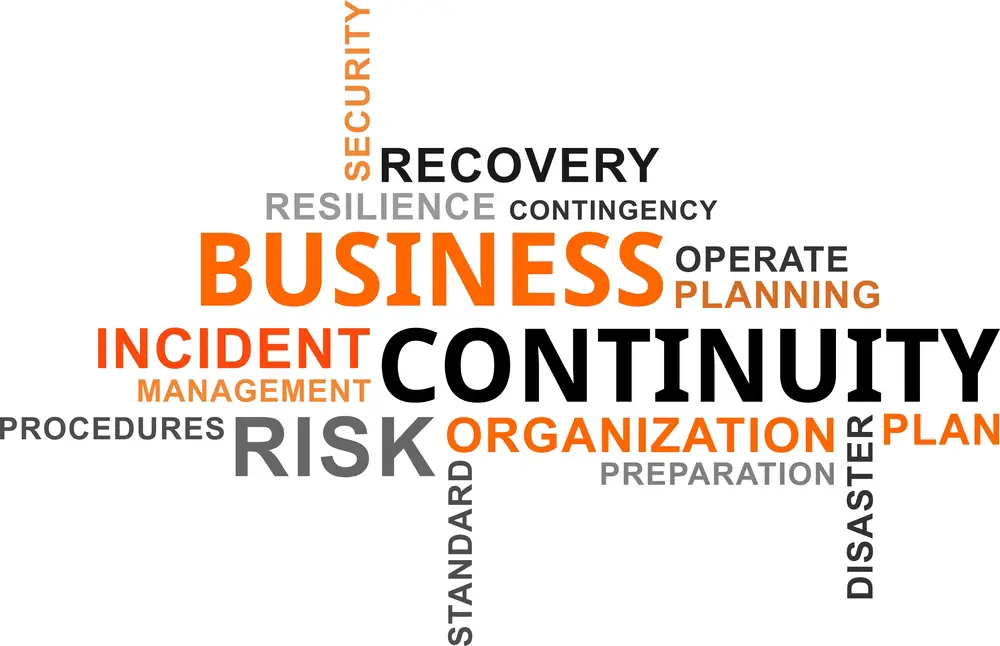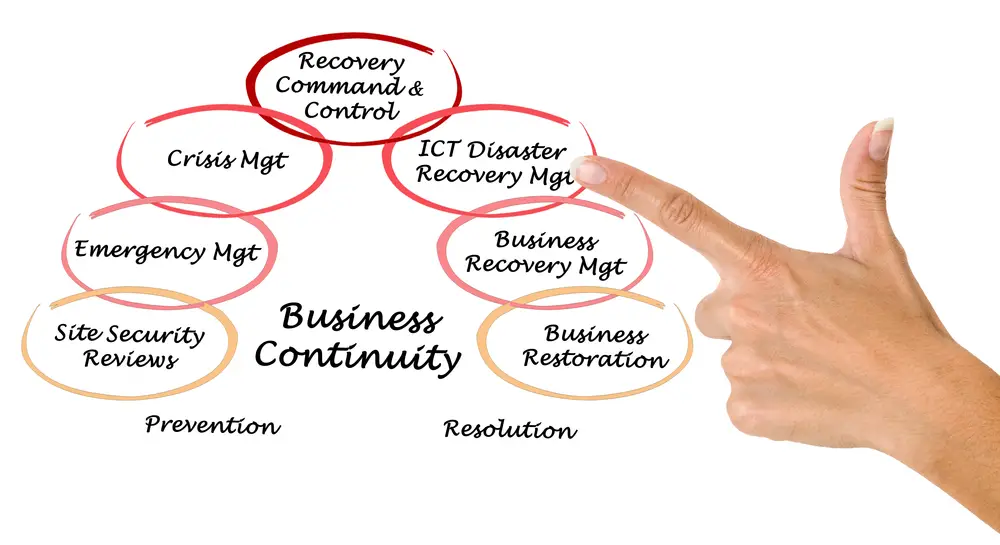As a business owner, it is your responsibility to ensure that you have an effective plan in place in case of any type of emergency to protect essential business functions. This is where business continuity management systems come into play. Business continuity management systems are designed to help businesses stay operational during and after a crisis, whether it be a natural disaster, power outage, or cyber-attacks.
A comprehensive business continuity plan can be used in many ways, but it is fundamental to the operation to keep organizations working after disruptive events. Although the BCM consists of numerous components, a key part includes BIA risk assessment, recovery planning, testing, and exercises.
When dealing with a major crisis can be tough. Business continuity plans elements should include workspace re-coverage and cyber resilience, change management, and other aspects. A second key aspect of this is sharing business continuity plans and the training required to cope when disaster hits.
This blog post will discuss the key components of business continuity management systems and why they are so important for any organization.
Risk Assessment & Analysis
The first step in setting up a business continuity management system is identifying potential risks that could disrupt or harm your operations. This involves conducting a risk assessment and analysis to determine what types of threats you may face and how likely they are to occur.
Risk assessments can include things like assessing the potential impact of natural disasters on your operations, evaluating the security of your IT infrastructure to prevent cyber-attacks, and analyzing the financial risks associated with certain decisions. Once you have identified potential risks, you can create a plan for how to address them if they occur.
Business Impact Analysis
After identifying potential risks, you should conduct a business impact analysis (BIA). This involves determining how much financial damage each risk could cause if it were to happen as well as how long it would take for your company to recover from such an event.
The BIA also helps you identify which parts of your operations are most critical and need to be protected in case of an emergency. By understanding the impact, each risk has on your organization’s finances and long-term sustainability, you can better prepare for future crises.
Disaster Recovery & Emergency Response Plan
Once you have identified potential risks and conducted a BIA, it is time to start creating a disaster recovery and emergency response plan (DR/ERP). This plan should include detailed instructions on responding in case any identified risk occurs and specific steps for restoring operations quickly after an incident and demonstrate business continuity.
It should also include contact information for key personnel who must be notified immediately if an emergency happens. Also, DR/ERPs should include regular testing procedures so that employees know their responsibilities when disaster strikes.

Business Continuity Management
Business Continuity Management (BCM) elements are essential to any successful organization. Its goal is to create a comprehensive system designed to prepare for, respond to, and recover from unexpected events that could disrupt normal business operations.
Throughout the process, risk identification and analysis are key components of BCM, helping organizations identify potential risks and develop strategies to minimize the impact of those risks on their daily operations.
Good BCM plans also strive to create backup solutions for communication systems and vital data, allowing businesses to continue functioning even if normal methods fail. When implemented properly, BCM can be a vital tool in helping businesses stay resilient when faced with difficult circumstances.
A business continuity plan provides an efficient means to protect businesses from disasters. This blog post discusses key aspects of effective BCM and discusses the importance of developing a business plan.
Business Continuity Management Process
Business continuity management (BCM) processes are steps or operations taken that help ensures that critical business operations will continue even when disasters or emergency situations arise.
The BCM process starts with risk assessment and identification of key business functions and continues by developing and implementing continuity plans. A BCM plan needs periodic testing to ensure it is effective. The BCM process will also be designed to provide employees with regular education and communication to ensure the continuity of operations.
Business Continuity Planning
Business continuity plans (BCPs) are measures that help ensure that essential operations can continue functioning when a disaster occurs. It includes plans to minimize disruption to businesses and provides provisions for human-induced and natural catastrophes.
Essential operation means the actions required to protect people’s lives, protect the environment, ensure public security or maintain critical infrastructure. It may include important business functions, including financial transactions, supply, or service.
Business Continuity Plan (BCP)
The business continuity plan represents the company’s entire reinsurance and recovery strategy as a whole. Continuity management is a core part of CM’s business continuity systems. It specifies everything necessary to take during a critical incident and describes preventive measures for reducing the risk.
If the BCP does its duty, it shouldn’t have any trouble when a disaster occurs. Executives, stakeholders, and staff have a clear idea of their actions.
Periodic review and recommendations
Similar to testing, a crucial part of business continuity is the continuous assessment of an existing plan/system. Often when a company develops its BCP, the business will recognize any deficiencies. Those weaknesses are documented along with the steps required to resolve them.
Those steps can range in complexity, from creating new recovery protocols to installing strong backups. It’s important that your planning is checked regularly to avoid unnecessary mistakes. When reviewing a BCP, it is important to note some of the key questions to remember when evaluating it.
Recovery Teams
Normally called the recovery team, these individuals have a major role to play during the planning process and the execution of emergencies. In general, the recovery team’s responsibility depends on the enterprise’s scale or the BCP’s scope.
It would be ideal for the team to have IT workers and staff in various business-critical sectors. This contact should not necessarily be an office manager. The emergency planning team needs to understand the components of a business continuity plan.
Backup locations and physical assets
The best strategy for managing your continuity plan includes finding, protecting, and identifying these secondary spaces and assets: Backup locations may be feasible for enterprises.
Testing & mock recovery
Companies must constantly evaluate the BCP. These include anything involving an emergency drill or reclaiming the lost data as a simulation.
Tests are conducted to check if a procedure described in a plan works. When the recovery system does not function the way the plan was designed, recovery teams have to return to the drawing board. Schedule periodic tests for continuity planning.
Risk assessment
A crucial task in managing your BIPC is assessing your unique risk profile. These key elements of risk assessments are important in identifying or mitigating a business risk or disruption in operations.
Disaster Recovery and Business Continuity Planning components
A company continuity plan defines operations procedures by documenting procedures for responding if a disruption occurs. Disaster recovery has a subset of all BCPs in that you will never be able to recover your data.
Ideally, before disasters were declared, a list of key factors was needed. Organizations need to consider several other crucial aspects of the business continuity plan needed for a successful recovery from unforeseen problems.
Communications
When unexpected disruption occurs, communicating with employees and stakeholders is critical. Human Resources Specialists have specialized roles involving maintaining unified communications among employees and the organization’s recovery effort.
Having an active social media presence on the site is crucial to the timely and accurate reporting of incoming incidents. Critical personnel need to understand incident response processes.
Identify critical functions
Identifying critical functions reveals which procedures are essential for running your business when an unexpected disruption occurs. Ideally, you need to identify your business priorities. It includes
Business Impact Analysis (BIA)
Business Impact Analysis (BIA) aims to provide information that is important in designing and implementing recovery plans. Below you can list some possible scenarios for business impact analyses.
Contact information and Service Level Agreements (SLAs)
Business continuity plans usually include contact information along with the SLAs. Then you must specify what follows.
Conclusion
Business continuity management systems are essential for any organization that wants to stay competitive in today’s marketplace. By identifying potential risks and conducting thorough analyses of their impacts on operations.
Businesses can develop comprehensive plans to help them remain operational during emergencies while minimizing losses due to downtime or other disruptions caused by unforeseen events. With proper planning and preparation, businesses can ensure they remain resilient no matter the challenges they may face.
Have you read?
Elements of business continuity management system
Key elements of business continuity management
What is a business continuity management system?
Business continuity management examples
What are key elements of business continuity management
Bcms business continuity management system
Business continuity management systems

Chris Ekai is a Risk Management expert with over 10 years of experience in the field. He has a Master’s(MSc) degree in Risk Management from University of Portsmouth and is a CPA and Finance professional. He currently works as a Content Manager at Risk Publishing, writing about Enterprise Risk Management, Business Continuity Management and Project Management.



